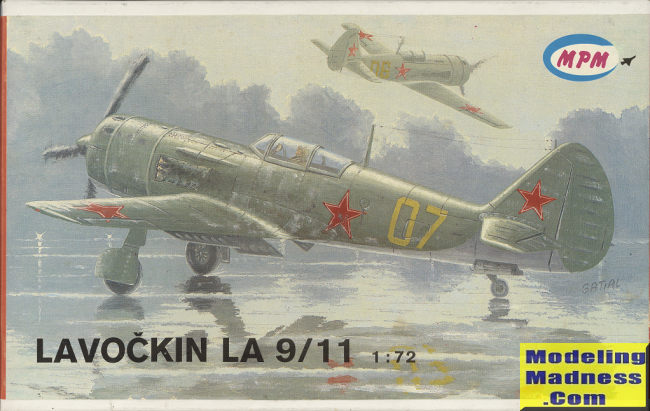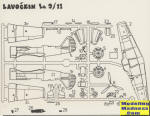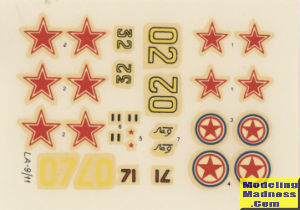
MPM 1/72 La-9/11
| KIT #: | 72004 |
| PRICE: | $ |
| DECALS: | Three options |
| REVIEWER: | Scott Van Aken |
| NOTES: | 1994 release |

| HISTORY |
La-9 represents further development of the Lavochkin La-126 prototype. The first prototype, designated La-130 was finished in 1946. Similarity to the famous Lavochkin La-7 was only superficial – the new fighter had all-metal construction and a laminar flow wing. Weight savings due to elimination of wood from the airframe allowed for greatly improved fuel capacity and four-cannon armament. Mock combat demonstrated that La-130 was evenly matched with La-7 but was inferior to Yakovlev Yak-3 in both horizontal and vertical planes. The new fighter, officially designated La-9, entered production in August 1946. A total of 1,559 aircraft were built by the end of production in 1948.
Only one La-9 remains in airworthy condition today, owned by Jerry Yagen of Virginia Beach, Va, restored by Pioneer Aero Restorations between 2001 and 2003. A handful of others remain in museums in China, Korea and one in Romania.
One of the recommendations from the government testing of Lavochkin La-130 (Lavochkin La-9 prototype) was to further develop it into a long-range escort fighter. The resultant La-134 prototype (also sometimes referred to as La-9M) featured increased fuel and oil capacity. Armament was reduced to three cannons. The prototype flew in May 1947. The second prototype, La-134D had fuel capacity increased by an additional 275 l (73 US gal) with wing and external fuel tanks. The aircraft was fitted with larger tires to accommodate the increased weight and amenities for long flights such as increased padding in the seat, armrests, and a urinal. In addition, a full radio navigation suite was installed. Not surprisingly, combat performance with a full fuel load suffered. However, as the fuel load approached that of La-9, so did the performance. The aircraft was found to be poorly suited for combat above 7,000 m (23,000 ft). The new fighter, designated La-11 (OKB designation La-140) entered production in 1947. By the end of production in 1951, a total of 1,182 aircraft were built.
| THE KIT |
 According to Scalemates, this is MPM's fourth 1/72 kit. There is a single
plastic sprue molded in a dark brown plastic. Detailing is fine engraved panel
lines. A still clear vacuform canopy is provided and one is expected to use the
scrap for the landing light cover and the clear panel behind the cockpit.
According to Scalemates, this is MPM's fourth 1/72 kit. There is a single
plastic sprue molded in a dark brown plastic. Detailing is fine engraved panel
lines. A still clear vacuform canopy is provided and one is expected to use the
scrap for the landing light cover and the clear panel behind the cockpit.
The kit does provide alternate pieces to do the La-9 that includes the lower scoop, different forward cowling, and a fairing that fits on the side of the forward fuselage. Those pieces are not needed for the La-11. Not surprising is that there are varying levels of flash on the parts that will need to be cleaned up prior to use.
The instructions first have your cut apart the gear doors unless you are doing an in-flight model. The rest of the instructions are a single exploded view showing where everything fits. The cockpit is a flat floor, control column, seat, rear bulkhead and instrument panel. A rather shallow radio panel fits behind the seat. No armored glass head protection is provided.
This is all trapped between the fuselage halves with the interior floor
fitting atop ledges molded in the fuselage halves. There is no sidewall detail
and in fact, you'll probably have to remove the ejection towers in the fuselage
halves and the wing sections. Once the fuselage is closed, the forward cowling
of choice is attached. Tailplanes are butt joined with the wing consisting of a
full lower half with molded in gear wells and two upper wing halves. Landing
gear has separate oleo scissors. I'm sure you'll need to drill out the wheels so
they will fit on the axles. Prop simply glues onto the forward cowling, followed
by the spinner.

As mentioned the instructions are basically an exploded view and provides generic color information for the exterior. Four view drawings are provided to help with overall placement. Markings are provided for three aircraft. One is a Soviet La-9 in overall light grey from 1946. Also in light grey are two La-11s. One is a Soviet plane from 1947. The other is a North Korean plane with large green areas on the upper surface from 1950. The two Soviet aircraft have red spinners. The decal sheet has yellowed over the years, but since the markings are fairly generic, you should be able to find replacements.
| CONCLUSIONS |
Kits of these fighters in this scale are few and far between. There have been several vacuforms while previous to this, the only injected plastic kit was by Siga, later reboxed by Interavia. It is said to be pretty terrible. Later, the La-9/11 was made by the resin kit maker Steelwork. You can find both of these in the archives. While by no means an easy kit to build, this one is probably the best injected plastic one out there and can still be found with a good web search.
October 2024
Copyright ModelingMadness.com. All rights reserved. No reproduction in part or in whole without express permission from the editor.
If you would like your product reviewed fairly and fairly quickly, please contact the editor or see other details in the Note to Contributors.